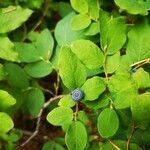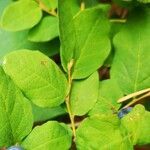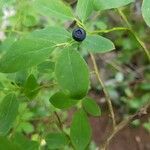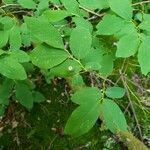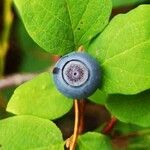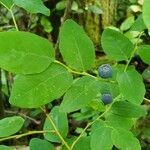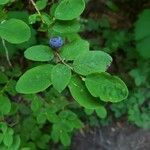A clumpy shrub. It is fairly narrow and upright. It grows 1 m high. It can grow 3 m high. It loses its leaves. It can form suckers if the roots are damaged. The young stems are angular and have grooves. The leaves are oval and have smooth edges. The leaves are pale green and paler underneath. The leaves are 3-6 cm long and 2-3 cm wide. The flowers appear before the leaves and are 1 cm long by 5 mm wide. They can be green or pink. The fruit are blue, purple or black berries. They are 8 mm across and are edible. They have a gritty texture. It can form hybrids with Vaccinium deliciosum and Vaccinium membranaceum.
Bushy-branched shrub to 1.5 m, crown-forming or seldom colonial; lvs thin, deciduous, elliptic or oval, 2–5 cm, obtuse or rounded at both ends, entire or aristate-serrulate only below the middle, glabrous, paler green beneath, on petioles 1–2 mm; fls solitary in the lower axils of the season, on spreading or decurved pedicels 4–8 mm; cal-lobes very short or nearly obsolete; cor 7–10 mm; much-constricted at the throat; anthers spurred; fr purplish-black, nearly 1 cm. Moist woods; Nf. to N.S. and e. Que.; n. Mich. and adj. Ont.; Black Hills; Alas. to Ida. and Oreg. May.
